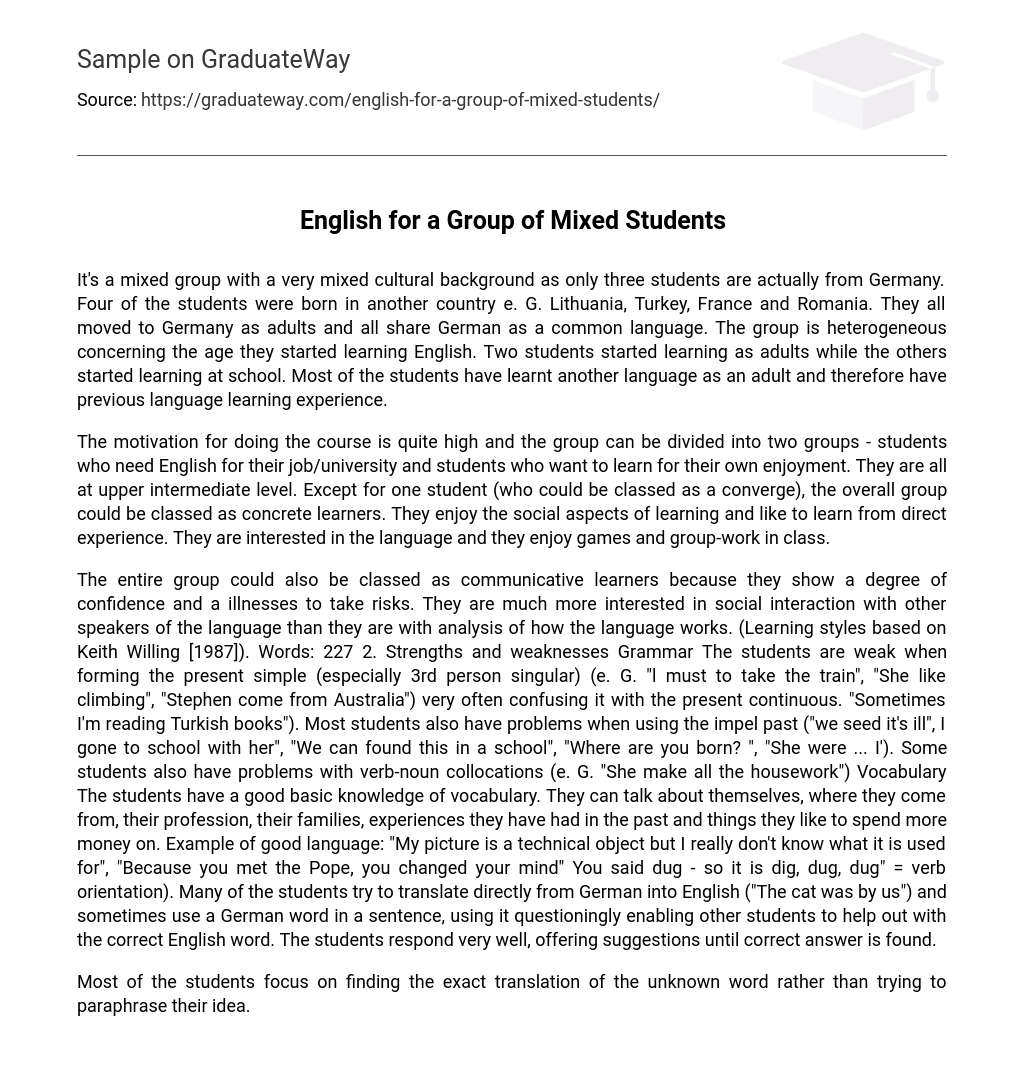It’s a mixed group with a very mixed cultural background as only three students are actually from Germany. Four of the students were born in another country e. G. Lithuania, Turkey, France and Romania. They all moved to Germany as adults and all share German as a common language. The group is heterogeneous concerning the age they started learning English. Two students started learning as adults while the others started learning at school. Most of the students have learnt another language as an adult and therefore have previous language learning experience.
The motivation for doing the course is quite high and the group can be divided into two groups – students who need English for their job/university and students who want to learn for their own enjoyment. They are all at upper intermediate level. Except for one student (who could be classed as a converge), the overall group could be classed as concrete learners. They enjoy the social aspects of learning and like to learn from direct experience. They are interested in the language and they enjoy games and group-work in class. The entire group could also be classed as communicative learners because they show a degree of confidence and a illnesses to take risks. They are much more interested in social interaction with other speakers of the language than they are with analysis of how the language works. (Learning styles based on Keith Willing [1987]).
Strengths and weaknesses Grammar The students are weak when forming the present simple (especially 3rd person singular) (e. G. “l must to take the train”, “She like climbing”, “Stephen come from Australia”) very often confusing it with the present continuous. “Sometimes I’m reading Turkish books”). Most students also have problems when using the impel past (“we seed it’s ill”, I gone to school with her”, “We can found this in a school”, “Where are you born? “, “She were … I’). Some students also have problems with verb-noun collocations (e. G. “She make all the housework”) Vocabulary The students have a good basic knowledge of vocabulary. They can talk about themselves, where they come from, their profession, their families, experiences they have had in the past and things they like to spend more money on. Example of good language: “My picture is a technical object but I really don’t know what it is used for”, “Because you met the Pope, you changed your mind” You said dug – so it is dig, dug, dug” = verb orientation).
Many of the students try to translate directly from German into English (“The cat was by us”) and sometimes use a German word in a sentence, using it questioningly enabling other students to help out with the correct English word. The students respond very well, offering suggestions until correct answer is found. Most of the students focus on finding the exact translation of the unknown word rather than trying to paraphrase their idea. Pronunciation All the students have a strong Al interference and speak with an accent. The group responds well to drilling the right pronunciation and where to put stress on the words. They are keen to sound natural and like repeating after the teacher. Some students pronounce the endings of words that aren’t necessary e. G. “clothes”, “See” instead of sea, “Lush their jobs”.
Strengths and weaknesses skills Reading The students are able to read a text fairly quickly in order to understand the overall meaning. After enquiring about a few words of vocabulary (sometimes looking this up themselves in a dictionary) they are able to answer all the questions quickly and correctly. Listening The students are able to listen to texts read to them and in most cases understand the general meaning already after the first time. After hearing the text for the second time, they are able to answer questions, in most cases correctly.
The students react well to instructions and during conversation they wait patiently until their dialogue partner has finished. One student is a panicky listener, the others all seem to be relaxed listeners. Writing The students have a wide range of vocabulary appropriate for the given tasks. Their sentences are well-structured and they make few mistakes. Speaking The students try to use structured sentences. If they are confident with the vocabulary hesitation is less frequent, with new vocabulary or grammar most students hesitate frequently.
The students are motivated to improve their speaking ability and they make a great effort to only speak English. Some of them use gestures when they do not know a word, others switch between German and English, using the German word to fill in the gaps in the sentence (“l go with the Starџenable”, “I make Twig with Simi and … I’). Recommendations Language development. Total English Workbook (Pre-intermediate). Grammar : Present Simple vs. Present Continuous Justification: All exercises on this page help the students to distinguish between the present simple and the present continuous. It also concerns activities they can associate with. New Cutting Edge (Pre-intermediate Student’s Book) Sarah Cunningham/Peter Moor – Pearson/Longing Publishers Module, page 34 Language Focus 1 Present continuous and present simple Justification: At the top left of the page there is a grammar exercise section where he students have to underline and give an example of the present simple/ present continuous.





